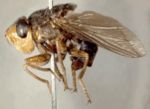Difference between revisions of "Dermatobia hominis"
Jump to navigation
Jump to search
| (14 intermediate revisions by 3 users not shown) | |||
| Line 1: | Line 1: | ||
| − | |||
| − | |||
| − | |||
| − | |||
| − | |||
| − | |||
| − | |||
| − | |||
| − | |||
| − | |||
| − | |||
| − | |||
| − | |||
| − | |||
| − | |||
[[Image:Human Bot fly.jpg|thumb|right|150px|''Human Bot Fly'' <br> J. Eibl 2007, WikiMedia Commons ]] | [[Image:Human Bot fly.jpg|thumb|right|150px|''Human Bot Fly'' <br> J. Eibl 2007, WikiMedia Commons ]] | ||
[[Image:Human Bot fly Larvae.jpg|thumb|right|150px|''Human Bot Fly Larvae'' - Captain R. Goodman 2007, WikiMedia Commons]] | [[Image:Human Bot fly Larvae.jpg|thumb|right|150px|''Human Bot Fly Larvae'' - Captain R. Goodman 2007, WikiMedia Commons]] | ||
| − | Also | + | *Also called the human bot fly |
| + | |||
| + | *Larvae are important parasites of both humans and animals | ||
| + | |||
| + | *Specifically found in South America | ||
| + | |||
| − | + | '''Recognition''' | |
| − | + | *Adult can grow up to 25mm in length | |
| − | + | *Similar to [[Calliphoridae|''Calliphora'']] in appearance | |
| − | + | **Blue-black | |
| + | **Yellow-orange head and legs | ||
| − | Larvae are distinctive as they taper towards the posterior end | + | *Larvae are distinctive as they taper towards the posterior end |
| − | |||
| − | |||
| − | + | '''Life cycle''' | |
| + | *Eggs laid on blood sucking flies such as mosquitoes | ||
| + | **These hatch when the mosquito next lands on a warm blooded animal | ||
| − | + | *Larvae penetrate skin causing painful swellings | |
| − | + | *Larvae emerge after 35-42 days and fall to ground to pupate | |
| − | |||
| − | |||
| − | |||
| − | + | *'''4 month''' life cycle | |
| − | |||
| + | '''Pathogenesis''' | ||
| + | *In humans, the larvae are most often found in swellings on the head and limbs | ||
| − | + | *Larvae cause painful swellings and distress to cattle | |
| − | + | *Larvae cause production losses | |
| + | |||
| + | *Wounds caused by exiting larvae can increase the prevalence of attack by other myiasis flies | ||
[[Category:Myiasis_Producing_Flies]] | [[Category:Myiasis_Producing_Flies]] | ||
| − | + | [[Category:To_Do_-_Max]] | |
| − | [[Category: | ||
Revision as of 11:09, 21 July 2010
- Also called the human bot fly
- Larvae are important parasites of both humans and animals
- Specifically found in South America
Recognition
- Adult can grow up to 25mm in length
- Similar to Calliphora in appearance
- Blue-black
- Yellow-orange head and legs
- Larvae are distinctive as they taper towards the posterior end
Life cycle
- Eggs laid on blood sucking flies such as mosquitoes
- These hatch when the mosquito next lands on a warm blooded animal
- Larvae penetrate skin causing painful swellings
- Larvae emerge after 35-42 days and fall to ground to pupate
- 4 month life cycle
Pathogenesis
- In humans, the larvae are most often found in swellings on the head and limbs
- Larvae cause painful swellings and distress to cattle
- Larvae cause production losses
- Wounds caused by exiting larvae can increase the prevalence of attack by other myiasis flies

